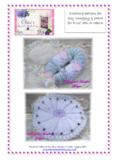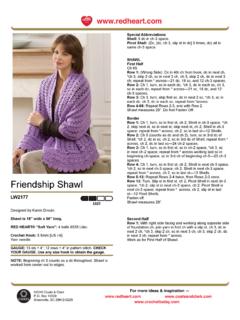Transcription of Shetland Pi Shawl KAL – Part One - Wendy Knits
1 Shetland Pi Shawl KAL Part One Wendy D. Johnson Yarn: I am using approximately 1400 yards of fingering weight yarn. Note that you can use pretty much any yarn in any weight for this project. Gauge: See my August 10, 2010 blog post for instructions for knitting a swatch. Needles: See my August 9, 2010 blog post for a discussion of needle sizes. The following is a good starting point for your swatching: Lace weight use a size 4 5. Fingering weight use a size 6 7. Sport or DK weight use a size 8 9. Worsted weight use a , size 10 11. If you are a tight knitter, try a larger size needle, and if you are a loose knitter, try a smaller size needle. You will need four double-pointed needles (dpns), one 24 long circular, and/or one 32" or 40 long circular (see note below). Note: You will start your Shawl using four double-pointed needles (dpns). As soon as your Shawl is large enough, you can transfer it to the 24 circular needle. Once you have transferred your stitches to a circular needle, mark the beginning of the round with a stitch marker.
2 I also recommend placing a stitch marker between each of the pattern repeats. Use a different color marker to mark the beginning of the round so you don't get confused. As your work grows, you can transfer your work to a longer circular needle if desired. Abbreviations K knit K2tog knit 2 together P purl PSSO pass slipped stitch over SL slip SSK Slip one stitch as if to knit, then slip the next stitch as if to purl. Insert left needle into the front loops of the slipped stitches and knit them together from this position (through the back loops). YO yarnover Start knitting: Using a long-tail cast-on, cast on 9 sts over dpns: 3 stitches each on 3 dpns. Join into a circle, being careful not to twist your stitches and knit 2 rounds. You may find it easier to work the first round if you lay your work down on a cushion or pillow. See my August 4, 2010 blog post for a discussion of an easy way to start a circular Shawl . An alternative cast-on you can use is Emily Ocker's Cast-on, which is documented in photos here.
3 Another alternative that looks very simple is the Belly Button Circular cast-on documented here. There are many videos available online that demonstrate circular cast-ons. Here is a listing of videos I. found via a Google search. Shetland Pi Shawl - Part One - 1. Increase Round 1: (K1, yo) around, so that you have doubled the number of your stitches 18. stitches. Work 4 rounds, knitting all the stitches. Increase Round 2: (K1, yo) around, so that you have doubled the number of your stitches 36. stitches. Work 8 rounds, knitting all stitches. Increase Round 3: (K 1, yo) around, so that you have doubled the number of your stitches 72. stitches. Work 1 round, knitting all stitches. While you knit this round, place a stitch marker after every 6th stitch, if desired, to help you keep your place in the pattern. Work Chart A, repeating the 6 stitches of the chart 12 times over the 72 stitches on your needles. Work Chart A 3 times, for a total of 12 rounds worked.
4 Chart A Chart Key K. s j j d 3 / P. / j YO. s j j d 1 d K2tog 5 3 1 s SSK. Chart A Pattern in Words Round 1: [K1, k2tog, yo twice, ssk, k1] repeat these 6 stitches 12 times. Round 2: [K3, p1 in the second yarnover from Round 1, k2] repeat these 6 stitches 12 times. Round 3: [K2tog, yo, k2, yo, ssk] repeat these 6 stitches 12 times. Round 4: Knit all stitches. Note that on Round 1, you will work two yarn-overs in a row. You do this by simply wrapping the yarn around the needle twice, instead of once, as you would do for a single yarn-over. Then on Round 2 you will knit the first yarn-over and purl the second yarn-over. After you finish working 12 rounds of Chart A, work 1 round, knitting all stitches. While you knit this round, remove all your stitch markers except the one that marks the beginning of the round. You have finished Part One! Wendy D. Johnson 08/10. All rights reserved. This pattern is for your personal, non-commercial use only.
5 You are not allowed to make items from this pattern for sale anywhere. You are not allowed to mass produce this pattern or item made from it. Shetland Pi Shawl - Part One - 2.







